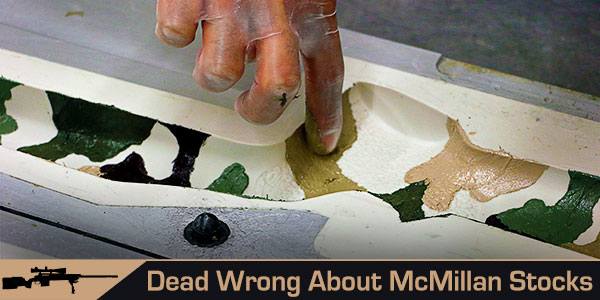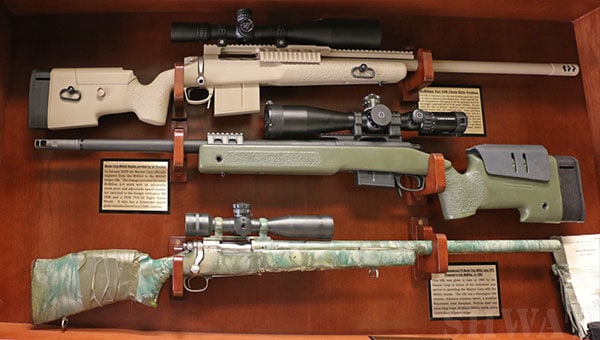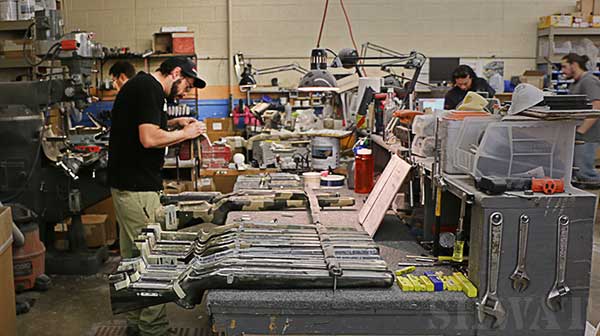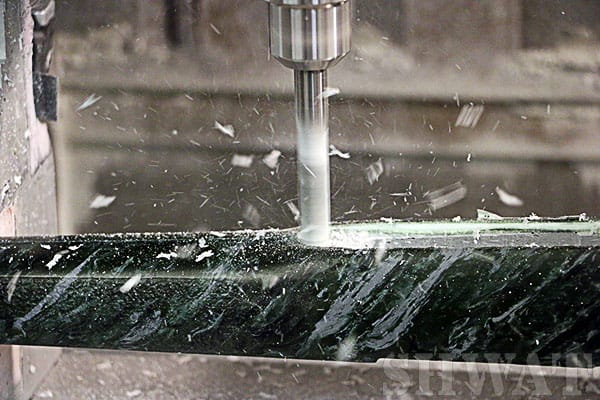 I was wrong. I was dead wrong.
I was wrong. I was dead wrong.
I had one of those moments where everything I had believed about something came crashing down. That moment came when I walked into McMillan’s Facility in Phoenix, Arizona.
I love walnut and I love maple. I know it’s not modern tactical today, but wood once was. I love the feel of a wood rifle stock in my hands. When I touch it I sense something special – human hands shaping and smoothing, finishing, and polishing a custom stock; or the history of the hands of past generations of young soldiers rubbing oil into a surplus rifle stock.
I was totally wrong.

McMillan has supplied military snipers with stocks for decades, and provided a rifle identical to the top rifle to Chris Kyle who used it while deployed.
I like the benefits of a modern fiberglass stock. I like the durability, the stability, and the immovability of a modern fiberglass stock. I like the imperviousness to weather, and the ease of refinishing for a like-new look. But I saw them as cold, soulless products of mass production, untouched by human hands. I pictured a Brave New World of rifle stocks, rank after rank, formed by cold machinery, identical, unexciting, untouched by human hands.
My visit to McMillan’s factory floor proved I couldn’t have been more wrong.
“Factory” falls short of describing this facility. “Factory” insinuates automation, machines stamping out parts.
Have you ever walked into a pottery studio? Do you know the feeling that such a place evokes? Dozens of hands molding clay into works of art, wielding paintbrushes, heads bent over intricate work; human hands in the act of creating.
My first impression of McMillan’s facility was just that. What I saw was not just a factory, it was a stock studio! I pivoted speechlessly in a circle, gazing at dozens of artistic hands deftly forming fiberglass art as my preconceived biases unraveled. I walked through the facility and I spoke to the artists. I saw their pride in their work.

All finish work is done by hand, including trimming and smoothing, drilling, testing, priming, painting, and installing recoil pads.
I saw that every step of the production of these stocks was accomplished or guided by human hands. I moved from station to station watching the myriad of steps being done by hand.
I will never look at a McMillan stock the same again.
Custom stocks
McMillan stocks are touched by up to 30 human hands during the manufacturing process. Each McMillan stock that is ordered is totally unique, custom built for the customer. The customer chooses the action inlet, barrel contour, bottom metal inlet, colors or patterns, molded in or surface finish, stock style, and options. When you order a McMillan stock, someone picks up your order and begins the process of building your stock to your specifications.
The fact that McMillan is producing over 12,000 custom stocks per year is an amazing feat, considering that these are one-of-a-kind pieces.
Exact fit
I have long been aware that many stock manufacturers have several standard inlets that they modify to force their stock to fit a specific barreled action. When you order a stock for your less-common rifle, you may get may a stock intended for a Remington 700, for example, that was then modified to fit your rifle reasonably well. McMillan does not do this.

Chips fly during insetting. The inletting process uses state of the art computer-controlled equipment for a perfect inlet. This is the only automated part of stock construction, but the process is guided by a McMillan employee every step of the way.
McMillan uses state-of-the-art equipment to cut for your exact action. They have thousands of precise inlet programs. McMillan can make inlets for all major actions and most obscure ones as well.
The CNC precision inletting of each stock is a hands-on-operation. The computer guides the cutting of perfectly precise inlets. But the process is guided, observed, and checked by a tech to insure precision and accuracy. Each stock then has an action mounted in it to insure a perfect fit. Racks and and racks of test actions hang on the walls for this purpose.

Actions used for testing inletting. McMillan has inletting programs for thousands of action, bottom metal, and barrel profile combinations. Each stock is custom inletted to the exact configuration, not modified from a generic inlet. The result is an exact fit to your action.
Whether your rifle is a common action, a military surplus action, or an obscure variation of a rare sporting rifle, McMillan does not have to figure out how to make a stock for it; they already know how. McMillan stocks are as close to a 1-to-1 fit as you can get.
They do not require a bedding block. McMillan has invested the time and effort to be able to bed an action correctly without taking shortcuts with bedding blocks. McMillan stocks do not require glass or epoxy bedding. They are drop-in fit without bedding, and have a track record in accuracy to prove it.
Orders
As with most suppliers of custom stocks, McMillan generally has a lead time. This is to be expected, since their stocks are among the most sought-after stocks for military and law enforcement snipers, competition shooters, and hunters. Thanks to hiring and training additional craftsmen, today lead times are half what they once were.
Some popular stock/inlet combinations now sit ready to ship. If you find something you like in their ready made selection, you can have a McMillan stock to your door in short order.
So, what do you get when you order a McMillan custom stock?
 You get a stock that was made for you from the very start. You get a stock that was made from the ground up for your rifle, not modified or adjusted for it. You get 30 human hands working to build your stock, to test it, to smooth and finish it, and to inspect it to insure top quality. You get the most precise CNC inlet available, not a bedding block that saves the manufacturer money, not a close inlet that needs final fitting, not an inlet that requires glass bedding. You get an exact inlet for your action, your barrel, and your bottom metal. You get one of what I believe to be the finest fiberglass stocks I have ever used.
You get a stock that was made for you from the very start. You get a stock that was made from the ground up for your rifle, not modified or adjusted for it. You get 30 human hands working to build your stock, to test it, to smooth and finish it, and to inspect it to insure top quality. You get the most precise CNC inlet available, not a bedding block that saves the manufacturer money, not a close inlet that needs final fitting, not an inlet that requires glass bedding. You get an exact inlet for your action, your barrel, and your bottom metal. You get one of what I believe to be the finest fiberglass stocks I have ever used.
And I have used them.
I have used McMillan stocks in the military, and installed McMillan stocks on guns for customers. I have a couple of my own projects on the horizon that will get McMillan stocks and I’ll be sure to share the results.
Oh, and remember that sense of history that comes from holding a surplus rifle with a walnut stock? The same feeling is there when I pick up that Vietnam-era sniper rifle and feel the worn fiberglass surface of the McMillan stock in my hands. Somehow it is all the more palpable to me now.


I do customer service, sales, tech support for McMillan. This is a pretty accurate write up. If anything, it leaves out certain impressive levels of craftsmanship & artistic finishing that goes into McMillan Fiberglass Stocks. The only thing I’ll add, as I deal with it everyday, is the quality starts the minute you start placing an order. If you have custom rifle components, it’s crucial that you’re on the exact same page as the person taking your order. Every gunsmith does things a bit differently, so it’s important when reporting certain dimensions, that you understand exactly what the guy on the phone is asking. We definitely take pride in the pursuit to build the perfect custom stock.
Thanks for commenting here, Fred! Great info you’ve shared!
Will the McMillan game scout accommodate a 1903a3 action?
That’s a good question for McMillan, http://www.mcmillanusa.com
I have contacted mcmillan reguarding inleting a flat top even for an 03 a3 in a mcmillan a5. Your best bet buy the configuration of stock you want in a non inleted flat top and take it to a gun smith to have it inleted. Aparently its not worth mcmillan or manners time. To truly make a custom rifle stock like they claim. They can do it if you have a nearly identical bad guy gun the k98 but cant spare the time to do an 03 even after i have informed them that a 1903 collector group of roughly 15,000+ members 90% have a custom 03 they want in a mcmillan. But aparently they dont want our money or buisness. Because it turns out they arent really. Interested in making customers dreams a reality or thanking outside the box. But instead want to stick to what they feel comfortable with instead of challanging their ceaftsmanship. I would have given $1,500 for the a5 for mine but as i said just not worth the time to them or aparently they dont truly do custom to order. Find it hard to believe with thousands of barreled actions in the system they dont have possibly the most significant.
You are unreasonable, you do not want a custom stock you want a factory drop in. If you would want a custom stock, perfectly fitted to your rifle you’d do as they suggest and purchase a flat top and have your Smith finish the job.
Great Write up. Have two McMillan A5’s with the molded in finish. They have been trough several years with a mix of recreational and competition/practice shooting and look as good as the day I bought them.These stocks are made to last.